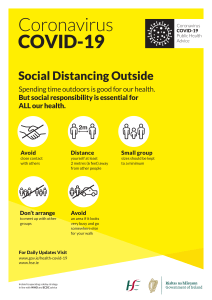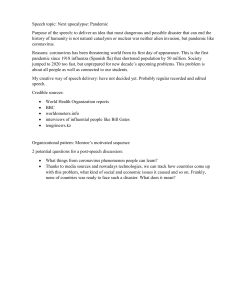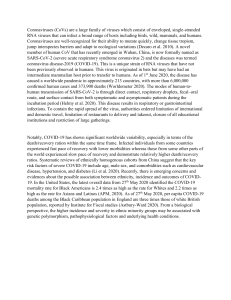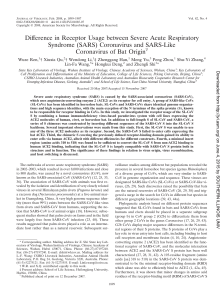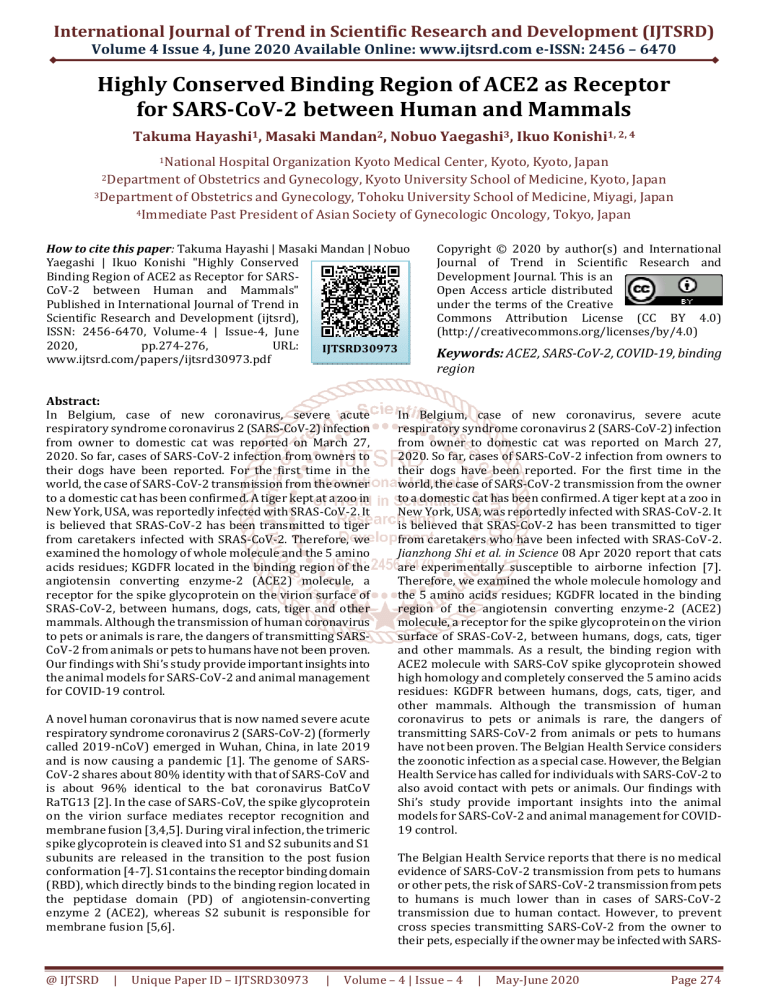
International Journal of Trend in Scientific Research and Development (IJTSRD)
Volume 4 Issue 4, June 2020 Available Online: www.ijtsrd.com e-ISSN: 2456 – 6470
Highly Conserved Binding Region of ACE2 as Receptor
for SARS-CoV-2 between Human and Mammals
Takuma Hayashi1, Masaki Mandan2, Nobuo Yaegashi3, Ikuo Konishi1, 2, 4
1National
Hospital Organization Kyoto Medical Center, Kyoto, Kyoto, Japan
of Obstetrics and Gynecology, Kyoto University School of Medicine, Kyoto, Japan
3Department of Obstetrics and Gynecology, Tohoku University School of Medicine, Miyagi, Japan
4Immediate Past President of Asian Society of Gynecologic Oncology, Tokyo, Japan
2Department
How to cite this paper: Takuma Hayashi | Masaki Mandan | Nobuo
Yaegashi | Ikuo Konishi "Highly Conserved
Binding Region of ACE2 as Receptor for SARSCoV-2 between Human and Mammals"
Published in International Journal of Trend in
Scientific Research and Development (ijtsrd),
ISSN: 2456-6470, Volume-4 | Issue-4, June
2020,
pp.274-276,
URL:
IJTSRD30973
www.ijtsrd.com/papers/ijtsrd30973.pdf
Abstract:
In Belgium, case of new coronavirus, severe acute
respiratory syndrome coronavirus 2 (SARS-CoV-2) infection
from owner to domestic cat was reported on March 27,
2020. So far, cases of SARS-CoV-2 infection from owners to
their dogs have been reported. For the first time in the
world, the case of SARS-CoV-2 transmission from the owner
to a domestic cat has been confirmed. A tiger kept at a zoo in
New York, USA, was reportedly infected with SRAS-CoV-2. It
is believed that SRAS-CoV-2 has been transmitted to tiger
from caretakers infected with SRAS-CoV-2. Therefore, we
examined the homology of whole molecule and the 5 amino
acids residues; KGDFR located in the binding region of the
angiotensin converting enzyme-2 (ACE2) molecule, a
receptor for the spike glycoprotein on the virion surface of
SRAS-CoV-2, between humans, dogs, cats, tiger and other
mammals. Although the transmission of human coronavirus
to pets or animals is rare, the dangers of transmitting SARSCoV-2 from animals or pets to humans have not been proven.
Our findings with Shi’s study provide important insights into
the animal models for SARS-CoV-2 and animal management
for COVID-19 control.
A novel human coronavirus that is now named severe acute
respiratory syndrome coronavirus 2 (SARS-CoV-2) (formerly
called 2019-nCoV) emerged in Wuhan, China, in late 2019
and is now causing a pandemic [1]. The genome of SARSCoV-2 shares about 80% identity with that of SARS-CoV and
is about 96% identical to the bat coronavirus BatCoV
RaTG13 [2]. In the case of SARS-CoV, the spike glycoprotein
on the virion surface mediates receptor recognition and
membrane fusion [3,4,5]. During viral infection, the trimeric
spike glycoprotein is cleaved into S1 and S2 subunits and S1
subunits are released in the transition to the post fusion
conformation [4-7]. S1contains the receptor binding domain
(RBD), which directly binds to the binding region located in
the peptidase domain (PD) of angiotensin-converting
enzyme 2 (ACE2), whereas S2 subunit is responsible for
membrane fusion [5,6].
@ IJTSRD
|
Unique Paper ID – IJTSRD30973
|
Copyright © 2020 by author(s) and International
Journal of Trend in Scientific Research and
Development Journal. This is an
Open Access article distributed
under the terms of the Creative
Commons Attribution License (CC BY 4.0)
(http://creativecommons.org/licenses/by/4.0)
Keywords: ACE2, SARS-CoV-2, COVID-19, binding
region
In Belgium, case of new coronavirus, severe acute
respiratory syndrome coronavirus 2 (SARS-CoV-2) infection
from owner to domestic cat was reported on March 27,
2020. So far, cases of SARS-CoV-2 infection from owners to
their dogs have been reported. For the first time in the
world, the case of SARS-CoV-2 transmission from the owner
to a domestic cat has been confirmed. A tiger kept at a zoo in
New York, USA, was reportedly infected with SRAS-CoV-2. It
is believed that SRAS-CoV-2 has been transmitted to tiger
from caretakers who have been infected with SRAS-CoV-2.
Jianzhong Shi et al. in Science 08 Apr 2020 report that cats
are experimentally susceptible to airborne infection [7].
Therefore, we examined the whole molecule homology and
the 5 amino acids residues; KGDFR located in the binding
region of the angiotensin converting enzyme-2 (ACE2)
molecule, a receptor for the spike glycoprotein on the virion
surface of SRAS-CoV-2, between humans, dogs, cats, tiger
and other mammals. As a result, the binding region with
ACE2 molecule with SARS-CoV spike glycoprotein showed
high homology and completely conserved the 5 amino acids
residues: KGDFR between humans, dogs, cats, tiger, and
other mammals. Although the transmission of human
coronavirus to pets or animals is rare, the dangers of
transmitting SARS-CoV-2 from animals or pets to humans
have not been proven. The Belgian Health Service considers
the zoonotic infection as a special case. However, the Belgian
Health Service has called for individuals with SARS-CoV-2 to
also avoid contact with pets or animals. Our findings with
Shi’s study provide important insights into the animal
models for SARS-CoV-2 and animal management for COVID19 control.
The Belgian Health Service reports that there is no medical
evidence of SARS-CoV-2 transmission from pets to humans
or other pets, the risk of SARS-CoV-2 transmission from pets
to humans is much lower than in cases of SARS-CoV-2
transmission due to human contact. However, to prevent
cross species transmitting SARS-CoV-2 from the owner to
their pets, especially if the owner may be infected with SARS-
Volume – 4 | Issue – 4
|
May-June 2020
Page 274
International Journal of Trend in Scientific Research and Development (IJTSRD) @ www.ijtsrd.com eISSN: 2456-6470
CoV-2, owners should avoid close contact with pets and
refrain from licking their faces. The information from our
examinations will support precision vaccine design and the
discovery of antiviral therapeutics, accelerating medical
countermeasure development.
Footnote
The materials (manuscript and figures) are original research,
has not been previously published and has not been
submitted for publication elsewhere while under
consideration.
Disclosure
The authors declare no potential conflicts of interest. The
funders had no role in study design, data collection and
analysis, decision to publish, or preparation of the
manuscript.
Acknowledgments
We thank Professor Richard A. Young (Whitehead Institute
for Biomedical Research, Massachusetts Institute of
Technology, Cambridge, MA) for his research assistance. This
study was supported in part by grants from the Japan
Ministry of Education, Culture, Science and Technology (No.
24592510, No. 15K1079, and No. 19K09840), the
Foundation of Osaka Cancer Research, The Ichiro Kanehara
Foundation for the Promotion of Medical Science and
Medical Care, the Foundation for Promotion of Cancer
Research, the Kanzawa Medical Research Foundation, The
Shinshu Medical Foundation, and the Takeda Foundation for
Medical Science.
References
[1] Coronavirus disease (COVID-2019) situation reports.
Geneva: World Health Organization, 2020.
(https://www.who.int/emergencies/diseases/novelcoronavirus-2019/situation-reports/).
H, Jiang RD, Liu MQ, Chen Y, Shen XR, Wang X, Zheng
XS, Zhao K, Chen QJ, Deng F, Liu LL, Yan B, Zhan FX,
Wang YY, Xiao GF, Shi ZL. A pneumonia outbreak
associated with a new coronavirus of probable bat
origin. Nature 579(7798), 270-273, 2020. doi:
10.1038/s41586-020-2012-7.
[3] Gallagher TM, Buchmeier MJ. Coronavirus spike
proteins in viral entry and pathogenesis. Virology 279,
371-374, 2001.
[4] Simmons G. Zmora P. Gierer S. Heurich A. Pöhlmann S.
Proteolytic activation of the SARS-coronavirus spike
protein: cutting enzymes at the cutting edge of antiviral
research. Antiviral Research 100, 605-614, 2013. doi:
10.1016/j.antiviral.2013.09.028.
[5] Yan R, Zhang Y, Li Y, Xia L, Guo Y, Zhou Q. Structural
basis for the recognition of SARS-CoV-2 by full-length
human ACE2. Science 367(6485), 1444-1448, 2020.
doi: 10.1126/science.abb2762
[6] Lu R, Zhao X, Li J, Niu P, Yang B, Wu H, Wang W, Song H,
Huang B, Zhu N, Bi Y, Ma X, Zhan F, Wang L, Hu T, Zhou
H, Hu Z, Zhou W, Zhao L, Chen J, Meng Y, Wang J, Lin Y,
Yuan J, Xie Z, Ma J, Liu WJ, Wang D, Xu W, Holmes EC,
Gao GF, Wu G, Chen W, Shi W, Tan W. Genomic
characterisation and epidemiology of 2019 novel
coronavirus: implications for virus origins and
receptor
binding.
Lancet
2020.
https://doi.org/10.1016/S0140-6736(20)30251-8
(2020).
[7] Shi J, Wen Z, Zhong G, Yang H, Wang C, Huang B, Liu R,
He X, Shuai L, Sun Z, Zhao Y, Liu P, Liang L, Cui P, Wang
J, Zhang X, Guan Y, Tan W, Wu G, Chen H, Bu Z.
Susceptibility of ferrets, cats, dogs, and other
domesticated animals to SARS-coronavirus 2. Science
08 Apr 2020: eabb7015 DOI: 10.1126/science.abb7015
[2] Zhou P, Yang XL, Wang XG, Hu B, Zhang L, Zhang W, Si
HR, Zhu Y, Li B, Huang CL, Chen HD, Chen J, Luo Y, Guo
@ IJTSRD
|
Unique Paper ID – IJTSRD30973
|
Volume – 4 | Issue – 4
|
May-June 2020
Page 275
International Journal of Trend in Scientific Research and Development (IJTSRD) @ www.ijtsrd.com eISSN: 2456-6470
Whole molecule homology and Amino acid sequence alignment of the binding region of angiotensin converting
enzyme 2 (ACE2) as receptor for SARS-CoV-2 spike glycoprotein and its phylogeny.
Whole molecule homology and the homologous binding region of Angiotensin Converting Enzyme 2 (ACE2) between human
and other animal species including dogs, cats, tiger, bats, pangolins and snakes are indicated in figure. The key 5 amino acid
residues KGDFR involved in the interaction with human SARS-CoV-2 spike glycoprotein are marked with the red bold words.
Detailed information including protein accession numbers of ACE2 of other animal species can be found in the supplementary
material.
@ IJTSRD
|
Unique Paper ID – IJTSRD30973
|
Volume – 4 | Issue – 4
|
May-June 2020
Page 276

